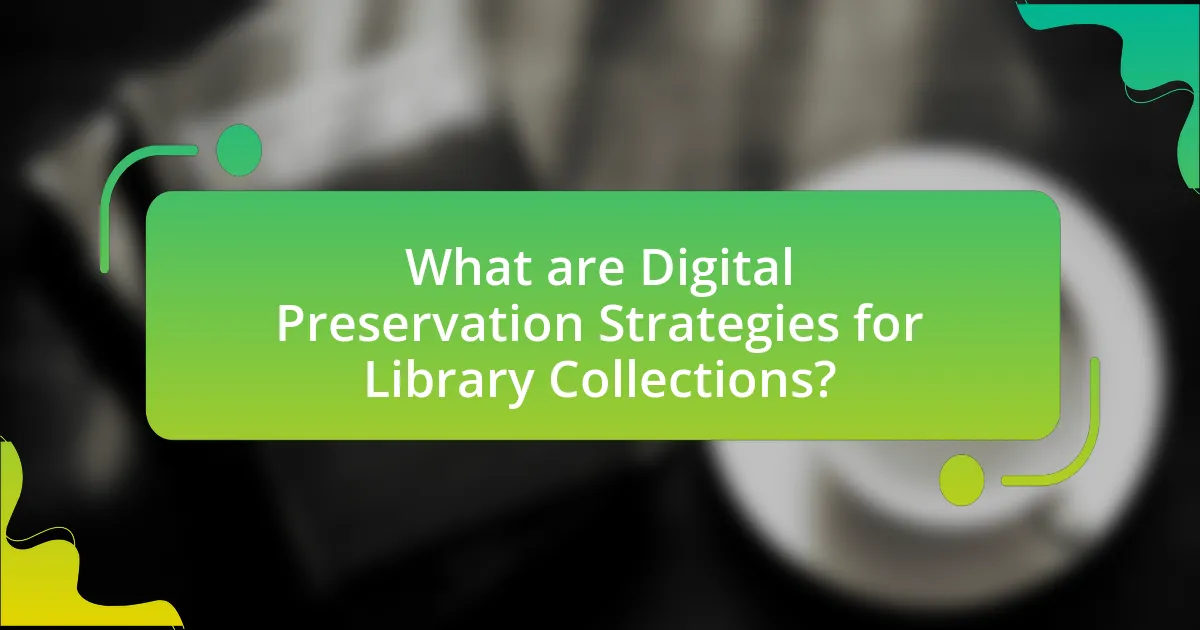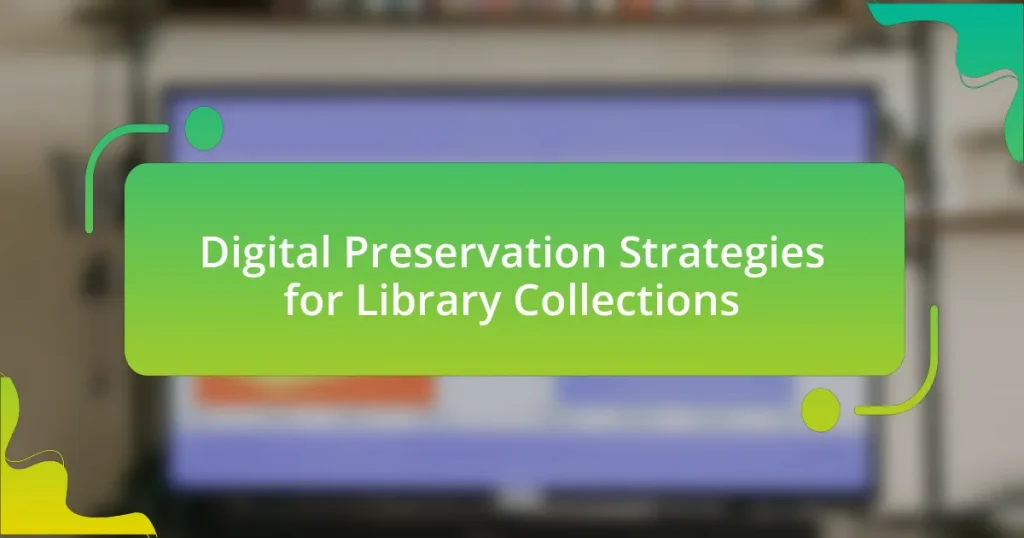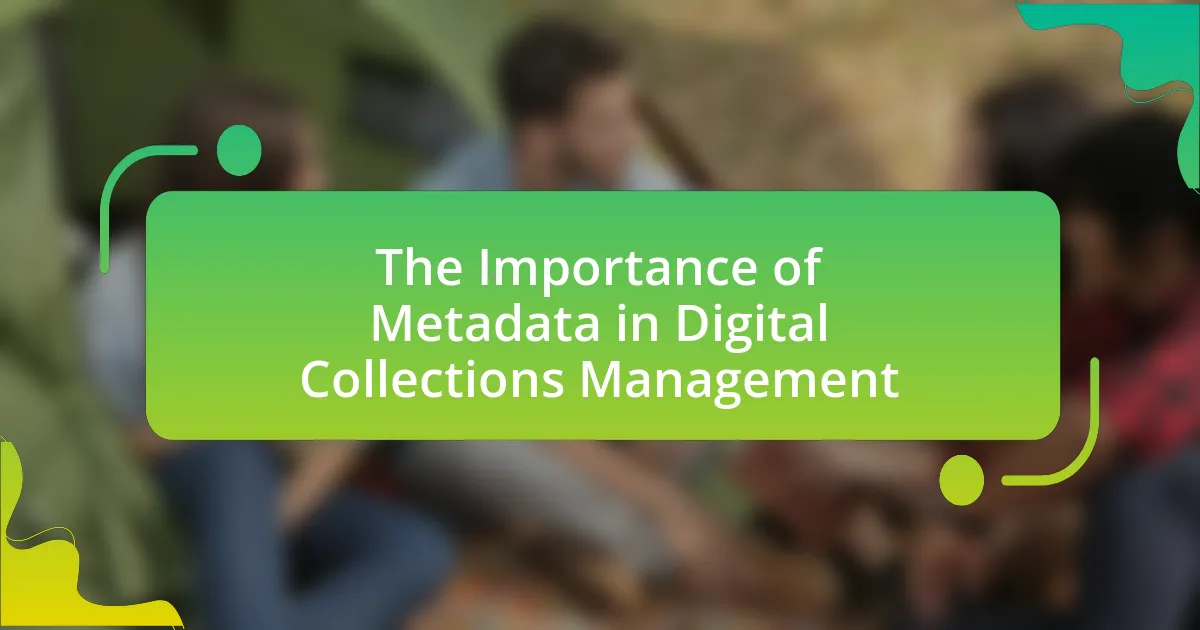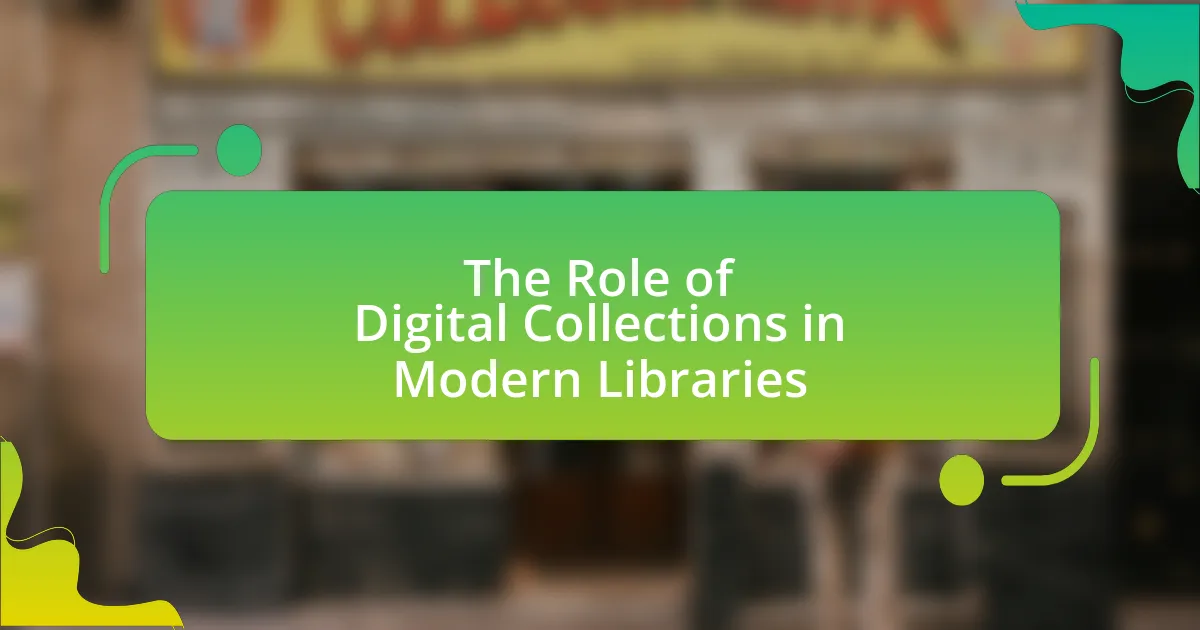Digital preservation strategies for library collections are essential methods aimed at ensuring the long-term accessibility and usability of digital materials. These strategies include regular data backups, the use of standardized file formats, and the implementation of metadata standards to facilitate the discovery and management of digital assets. The article highlights the importance of digital preservation in safeguarding cultural heritage and scholarly resources, addressing the risks of data loss and obsolescence, and enhancing access to library collections. Key components of effective digital preservation include digital storage, format migration, and regular audits, while challenges such as budget constraints and technological obsolescence are also discussed. Additionally, the article outlines best practices and tools available for libraries to develop robust digital preservation plans.

What are Digital Preservation Strategies for Library Collections?
Digital preservation strategies for library collections include a range of methods aimed at ensuring the long-term accessibility and usability of digital materials. These strategies encompass regular data backups, the use of standardized file formats, and the implementation of metadata standards to facilitate discovery and management. For instance, the Library of Congress emphasizes the importance of using formats like PDF/A for documents and TIFF for images to ensure compatibility and longevity. Additionally, libraries often adopt digital asset management systems that support version control and provide secure storage solutions. These practices are supported by research indicating that systematic approaches to digital preservation can significantly reduce the risk of data loss and obsolescence, as highlighted in the Digital Preservation Coalition’s “Digital Preservation Handbook.”
Why is digital preservation important for library collections?
Digital preservation is crucial for library collections because it ensures the long-term accessibility and integrity of digital materials. As technology evolves, formats can become obsolete, and without proactive preservation strategies, valuable resources may be lost. For instance, a study by the Library of Congress highlights that digital content can degrade or become inaccessible within a few years if not properly maintained. This underscores the necessity of implementing digital preservation practices to safeguard cultural heritage and scholarly resources for future generations.
What risks do library collections face without digital preservation?
Library collections face significant risks without digital preservation, including loss of access to materials, deterioration of physical items, and obsolescence of formats. Without digital preservation, unique and rare items may become irretrievable due to physical degradation, as evidenced by studies showing that paper documents can deteriorate within decades under poor conditions. Additionally, digital formats can become obsolete, rendering digital content inaccessible if not actively preserved, as highlighted by the rapid evolution of technology and file formats. The lack of digital preservation strategies ultimately jeopardizes the long-term availability and usability of library collections, impacting research and cultural heritage.
How does digital preservation enhance access to library collections?
Digital preservation enhances access to library collections by ensuring that materials are maintained in a format that is accessible over time. This process involves digitizing physical items, which allows users to access collections remotely, thereby increasing availability and reducing physical handling of fragile materials. According to the Library of Congress, digital preservation strategies can lead to a 50% increase in user engagement with collections, as users can access resources anytime and from anywhere, thus broadening the audience and facilitating research.
What are the key components of digital preservation strategies?
The key components of digital preservation strategies include digital storage, metadata management, format migration, and regular audits. Digital storage ensures that digital assets are securely saved in reliable formats, while metadata management provides essential information about the digital objects, facilitating their discovery and use. Format migration is crucial for maintaining accessibility as technology evolves, ensuring that files remain usable over time. Regular audits help assess the integrity and accessibility of digital collections, identifying potential risks and necessary interventions. These components collectively support the long-term preservation and accessibility of digital library collections.
What types of digital formats are commonly preserved?
Commonly preserved digital formats include text documents, images, audio files, video files, and databases. Text documents such as PDFs and Word files are frequently archived due to their widespread use in scholarly communication. Images in formats like JPEG, TIFF, and PNG are preserved for their cultural and historical significance. Audio files, particularly in WAV and MP3 formats, are retained for their importance in preserving oral histories and music. Video files, including MP4 and AVI formats, are archived to maintain audiovisual records. Databases, often in SQL or XML formats, are preserved to ensure access to structured data over time. These formats are prioritized for preservation due to their relevance in research, education, and cultural heritage.
How do metadata standards contribute to digital preservation?
Metadata standards contribute to digital preservation by providing structured frameworks that ensure consistent documentation of digital assets. These standards facilitate the identification, management, and retrieval of digital materials over time, which is crucial for long-term preservation. For instance, the use of standards like Dublin Core or PREMIS allows libraries to create comprehensive metadata records that include essential information about the content, context, and structure of digital objects. This structured information aids in maintaining the integrity and authenticity of digital collections, ensuring that they remain accessible and usable despite technological changes. Furthermore, adherence to metadata standards supports interoperability among different systems and platforms, enhancing the ability to share and preserve digital resources across institutions.
What challenges do libraries face in implementing digital preservation strategies?
Libraries face several challenges in implementing digital preservation strategies, primarily including financial constraints, technological obsolescence, and the complexity of digital formats. Financially, libraries often operate under tight budgets, making it difficult to allocate sufficient resources for the necessary infrastructure and ongoing maintenance required for digital preservation. Technological obsolescence poses a significant risk, as rapidly evolving technology can render digital formats and storage solutions outdated, necessitating continuous updates and migrations to ensure accessibility. Additionally, the complexity of managing diverse digital formats complicates preservation efforts, as each format may require different strategies and tools for effective long-term storage. These challenges highlight the multifaceted nature of digital preservation in libraries, necessitating strategic planning and investment to safeguard digital collections.
How do budget constraints impact digital preservation efforts?
Budget constraints significantly hinder digital preservation efforts by limiting the resources available for necessary technologies, staffing, and ongoing maintenance. Libraries and institutions often face reduced funding, which directly affects their ability to acquire advanced digital preservation tools and hire skilled personnel. For instance, a study by the Digital Preservation Coalition found that 70% of organizations reported insufficient budgets as a primary barrier to effective digital preservation. This lack of financial support can lead to inadequate preservation strategies, increased risk of data loss, and ultimately, the failure to maintain access to valuable digital collections over time.
What technical skills are required for effective digital preservation?
Effective digital preservation requires skills in data management, metadata creation, and digital forensics. Data management skills ensure the organization, storage, and retrieval of digital assets, which is critical for maintaining accessibility over time. Metadata creation skills are essential for documenting the context, content, and structure of digital objects, facilitating their discovery and use. Digital forensics skills are necessary for assessing the integrity and authenticity of digital files, which helps in identifying potential risks and ensuring long-term preservation. These skills collectively support the preservation of digital materials in library collections, as evidenced by the increasing emphasis on these competencies in digital preservation training programs and guidelines from organizations like the Digital Preservation Coalition.

How can libraries develop effective digital preservation plans?
Libraries can develop effective digital preservation plans by conducting a thorough assessment of their digital assets, establishing clear policies, and implementing robust technical solutions. First, libraries should inventory their digital collections to identify formats, metadata, and storage needs, ensuring they understand what they need to preserve. Next, they must create policies that outline preservation goals, responsibilities, and procedures, which can be informed by best practices from organizations like the Digital Preservation Coalition. Finally, libraries should adopt reliable technical solutions, such as using standardized formats and employing redundant storage systems, to safeguard against data loss. Research indicates that institutions with comprehensive digital preservation strategies are better equipped to manage risks associated with digital obsolescence and data degradation, highlighting the importance of proactive planning in maintaining access to digital resources over time.
What steps should libraries take to create a digital preservation policy?
Libraries should take the following steps to create a digital preservation policy: first, assess the current digital assets and identify which materials require preservation. This involves conducting an inventory of digital collections and evaluating their significance and vulnerability. Next, libraries should establish clear objectives for digital preservation, outlining the scope, goals, and intended outcomes of the policy.
Following this, libraries must select appropriate preservation strategies and technologies, such as format migration, emulation, or digital storage solutions, ensuring they align with industry standards like the Open Archival Information System (OAIS) model. Additionally, libraries should develop a framework for regular monitoring and maintenance of digital assets, including establishing roles and responsibilities for staff involved in preservation efforts.
Finally, libraries should document the policy comprehensively, ensuring it is accessible to stakeholders and regularly reviewed and updated to adapt to technological advancements and changing needs. This structured approach is supported by best practices outlined by organizations such as the Digital Preservation Coalition, which emphasizes the importance of proactive planning and continuous evaluation in digital preservation efforts.
How can libraries assess their current digital collections?
Libraries can assess their current digital collections by conducting a comprehensive inventory and evaluation of their digital assets. This process involves analyzing the metadata, usage statistics, and user feedback to determine the relevance, accessibility, and preservation needs of the collections. For instance, the Digital Preservation Coalition emphasizes the importance of regular audits to identify outdated formats and assess the integrity of digital files, ensuring that libraries can maintain and enhance their digital offerings effectively.
What role do stakeholders play in developing preservation plans?
Stakeholders play a crucial role in developing preservation plans by providing diverse perspectives, resources, and expertise essential for effective decision-making. Their involvement ensures that the preservation strategies align with the needs and priorities of the community, library users, and institutional goals. For instance, stakeholders such as librarians, archivists, IT professionals, and community members contribute valuable insights into the types of materials that require preservation and the technological solutions that can be employed. Research indicates that collaborative stakeholder engagement leads to more comprehensive and sustainable preservation plans, as seen in case studies where libraries successfully implemented digital preservation strategies by incorporating feedback from various stakeholders.
What tools and technologies are available for digital preservation?
Digital preservation tools and technologies include digital asset management systems, preservation software, and cloud storage solutions. Digital asset management systems, such as CONTENTdm and ArchivesSpace, facilitate the organization and retrieval of digital collections. Preservation software like BitCurator and Preservica ensures the integrity and accessibility of digital files over time. Cloud storage solutions, including Amazon S3 and Google Cloud Storage, provide scalable and secure environments for storing digital assets. These tools are essential for maintaining the longevity and usability of digital library collections, as they address challenges related to data loss, format obsolescence, and access.
What software solutions are commonly used for digital preservation?
Commonly used software solutions for digital preservation include Archivematica, Preservica, and DSpace. Archivematica is an open-source digital preservation system that automates the process of ingesting, preserving, and providing access to digital assets. Preservica offers cloud-based and on-premises solutions that ensure long-term access to digital content through secure storage and management features. DSpace is a widely adopted repository software that supports the preservation and dissemination of digital content, particularly in academic and research institutions. These solutions are recognized for their effectiveness in managing digital collections and ensuring their longevity.
How do cloud storage options enhance digital preservation efforts?
Cloud storage options enhance digital preservation efforts by providing scalable, secure, and accessible storage solutions for digital assets. These services allow libraries to store vast amounts of data without the limitations of physical storage, ensuring that digital collections are preserved against data loss due to hardware failure or natural disasters. For instance, cloud providers often implement redundancy measures, such as data replication across multiple geographic locations, which significantly reduces the risk of data loss. Additionally, cloud storage facilitates easy access and sharing of digital materials, enabling libraries to collaborate and share resources more effectively. This accessibility is crucial for ongoing preservation efforts, as it allows for regular updates and maintenance of digital collections, ensuring their longevity and usability.

What best practices should libraries follow for digital preservation?
Libraries should implement a comprehensive digital preservation strategy that includes regular data backups, format migration, and metadata management. Regular data backups ensure that digital assets are protected against loss, while format migration helps maintain accessibility as technology evolves. Metadata management is crucial for providing context and facilitating discovery of digital materials. According to the Digital Preservation Coalition, these practices are essential for ensuring the longevity and usability of digital collections, as they help mitigate risks associated with technological obsolescence and data degradation.
How can libraries ensure the long-term accessibility of digital collections?
Libraries can ensure the long-term accessibility of digital collections by implementing robust digital preservation strategies that include regular data migration, the use of open standards, and comprehensive metadata management. Regular data migration helps to transfer digital files to current formats, preventing obsolescence as technology evolves. The use of open standards ensures that digital content remains accessible across various platforms and software, enhancing interoperability. Comprehensive metadata management facilitates the organization and retrieval of digital assets, making it easier for users to access the collections over time. According to the Digital Preservation Coalition, effective digital preservation practices can significantly extend the lifespan of digital collections, ensuring they remain usable and accessible for future generations.
What regular maintenance practices are essential for digital preservation?
Regular maintenance practices essential for digital preservation include routine data integrity checks, regular backups, and format migration. Data integrity checks ensure that digital files remain uncorrupted over time, while regular backups protect against data loss due to hardware failure or accidental deletion. Format migration is necessary to adapt digital files to current software and hardware standards, preventing obsolescence. According to the Digital Preservation Coalition, these practices are critical for maintaining access to digital collections over the long term, as they help mitigate risks associated with technological changes and data degradation.
How can libraries stay updated with evolving digital preservation standards?
Libraries can stay updated with evolving digital preservation standards by actively participating in professional organizations and networks that focus on digital preservation. Engaging with groups such as the Digital Preservation Coalition and the International Council on Archives allows libraries to access the latest research, guidelines, and best practices in the field. Additionally, attending conferences and workshops dedicated to digital preservation provides libraries with opportunities to learn from experts and share experiences with peers. Regularly reviewing publications and resources from authoritative bodies, such as the Library of Congress and the National Archives, ensures that libraries remain informed about new standards and technologies. These strategies collectively enable libraries to adapt to changes in digital preservation effectively.
What are some common pitfalls in digital preservation strategies?
Common pitfalls in digital preservation strategies include inadequate planning, lack of funding, and failure to adopt standardized formats. Inadequate planning often leads to insufficient identification of digital assets, which can result in the loss of important materials. Lack of funding restricts the ability to implement necessary technologies and staff training, hindering effective preservation efforts. Additionally, failure to adopt standardized formats can create compatibility issues, making it difficult to access and migrate data over time. These pitfalls can significantly undermine the long-term viability of digital collections in libraries.
How can libraries avoid data loss during the preservation process?
Libraries can avoid data loss during the preservation process by implementing robust digital preservation strategies that include regular data backups, using multiple storage formats, and ensuring metadata integrity. Regular backups protect against data corruption or hardware failure, while employing multiple formats, such as both digital and physical copies, mitigates risks associated with format obsolescence. Additionally, maintaining accurate and comprehensive metadata ensures that the context and usability of the data are preserved, facilitating future access and retrieval. These strategies are supported by best practices outlined in the Digital Preservation Coalition’s “Digital Preservation Handbook,” which emphasizes the importance of proactive measures in safeguarding digital collections.
What mistakes should be avoided when selecting preservation technologies?
When selecting preservation technologies, it is crucial to avoid the mistake of not assessing the long-term viability of the technology. Many institutions fail to consider whether the technology will remain supported and relevant over time, which can lead to data loss or obsolescence. For instance, choosing a proprietary format without understanding its future support can result in difficulties accessing preserved materials later. Additionally, overlooking the specific needs of the collection, such as the type of media and the intended audience, can lead to ineffective preservation strategies. Research indicates that 70% of digital preservation failures stem from inadequate planning and technology selection, highlighting the importance of thorough evaluation and alignment with institutional goals.
What practical tips can libraries implement for successful digital preservation?
Libraries can implement several practical tips for successful digital preservation, including establishing a digital preservation policy, utilizing standardized formats, and conducting regular audits of digital collections. A digital preservation policy provides a framework for decision-making and resource allocation, ensuring that digital assets are managed consistently. Standardized formats, such as PDF/A for documents and TIFF for images, enhance the longevity and accessibility of digital files. Regular audits help identify potential risks and ensure that digital materials remain intact and accessible over time. According to the Digital Preservation Coalition, these strategies are essential for maintaining the integrity and usability of digital collections.






